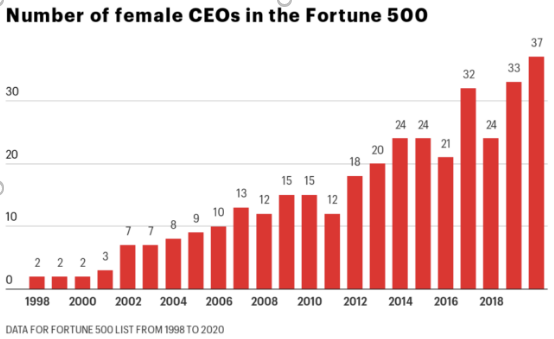Female Bosses
- Zaha Kırmızıtoprak
- Oct 4, 2021
- 2 min read
Most assume the worst when talking about the status of females in business. When asked the question ‘How many companies in the world have a woman as a top manager or CEO?’ people answered 2 percent or 10 percent from the three-choice multiple questions. The third option was 18 percent. The misconception of the fact that female bosses are rare, people underestimate their own skills and lower their chances.
Gender bias is an issue seen in every aspect of our lives; this problem took a whole other level in business. 42% of women encounter gender discrimination at work and women receive pay raises 5% less often. Gender discrimination can be seen in any stages from recruiting, hiring, and retaining employees. A girl named Erin McKavely was looking for a job after she graduated college and did not receive a single response from any of the employers, anyhow when she changed her name from Erin to Mack (which is considered a more masculine name) she received a 70% response rate. This is a great real-life example that shows the sad truth about applying to jobs as a woman. (Reiners, 2021)
According to Global Gender Gap Report in 2020, it will take another 100 years for gender equality in the workplace based on current efforts, and the pandemic, which especially affected women and caused them to lose jobs, worsened the situation. It has been proven that more women lost their jobs compared to men. The COVID-19 pandemic also triggered the gender inequality topics, people paid less attention to it, and many forgot the real issue. (Gender equality in the workspace: going beyond women on the board, 2021).
On the bright side of all this negativity, slowly the gender inequality rate is decreasing, and the number of female bosses is increasing. The annual list of Fortune 500 which is a ranking of the five hundred largest US industrial corporation measured by the gross income. Last year 33 of the 500 has woman leaders and this year it has 37. Though it still makes up less than 10 percent of the 500 its important to cherish the acceleration of the number throughout the years. (Some good news about gender equality that you may have missed, 2020). Below, you can view of a graph of the number of female CEOs in the fortune 500 list.

In 1998 there were 2 female CEO’s and after 20 years that number went up by 35.
At the moment, businesses are still heavily male-dominated, however people still underestimate the number of women who made it to the top. As I mentioned this misconception must be stopped as it affects the rate of change. This will also affect how younger girls view their chances of becoming successful businesswomen and CEO’s as they would not aim high enough due to the outdated worldview from their elderlies, parents, teachers, and boys that assume men are better leaders.
Reiners, B. (n.d.). What is gender bias in the workplace? Built In. Retrieved October 1, 2021, from https://builtin.com/diversity-inclusion/gender-bias-in-the-workplace
Gender equality in the workplace: Going beyond women on the Board. Accelerating Progress. (n.d.). Retrieved October 1, 2021, from https://www.spglobal.com/esg/csa/yearbook/articles/gender-equality-workplace-going-beyond-women-on-the-board
Some good news about gender equality that you may have missed. UN Women. (n.d.). Retrieved October 1, 2021, from https://www.unwomen.org/en/news/stories/2020/8/compilation-good-news-you-might-have-missed






Commentaires